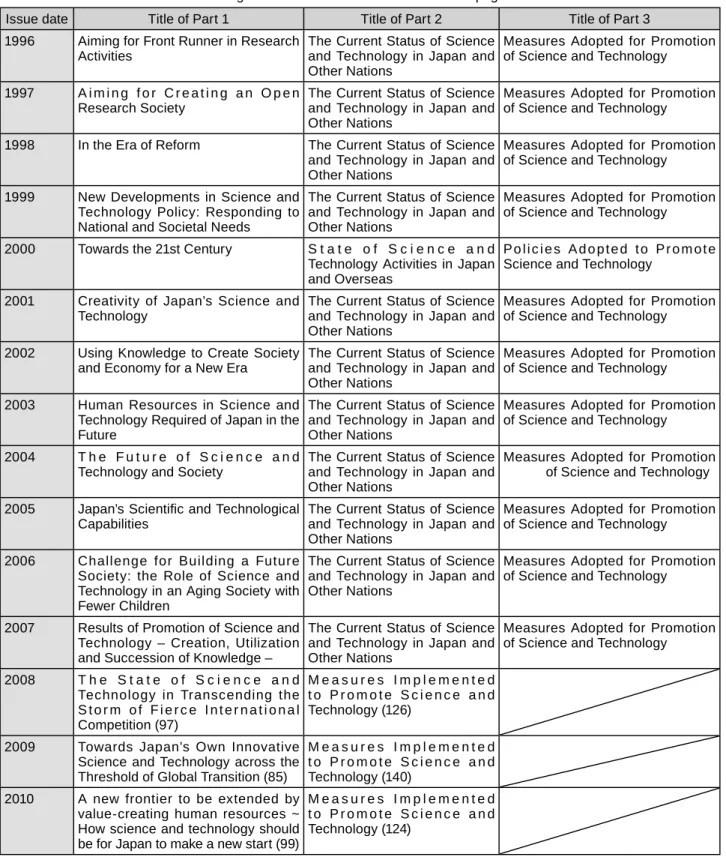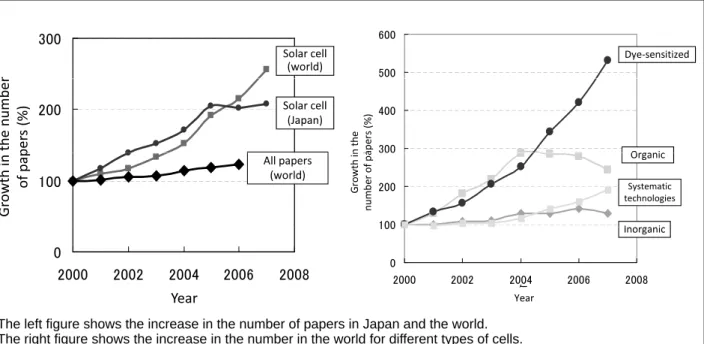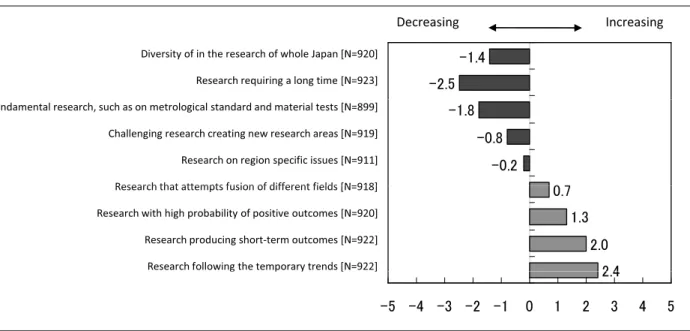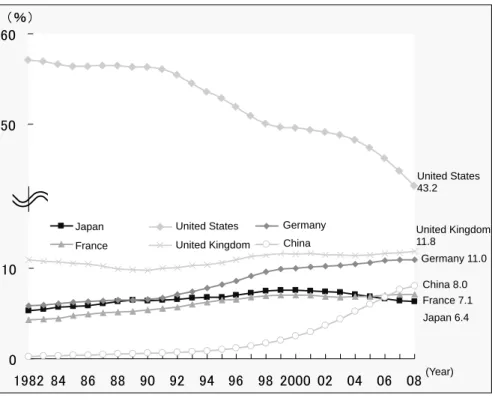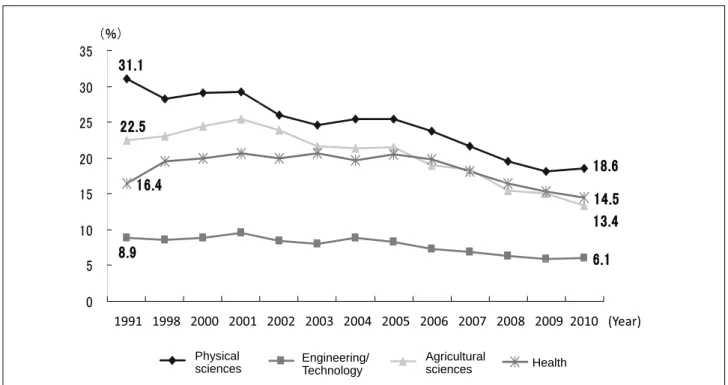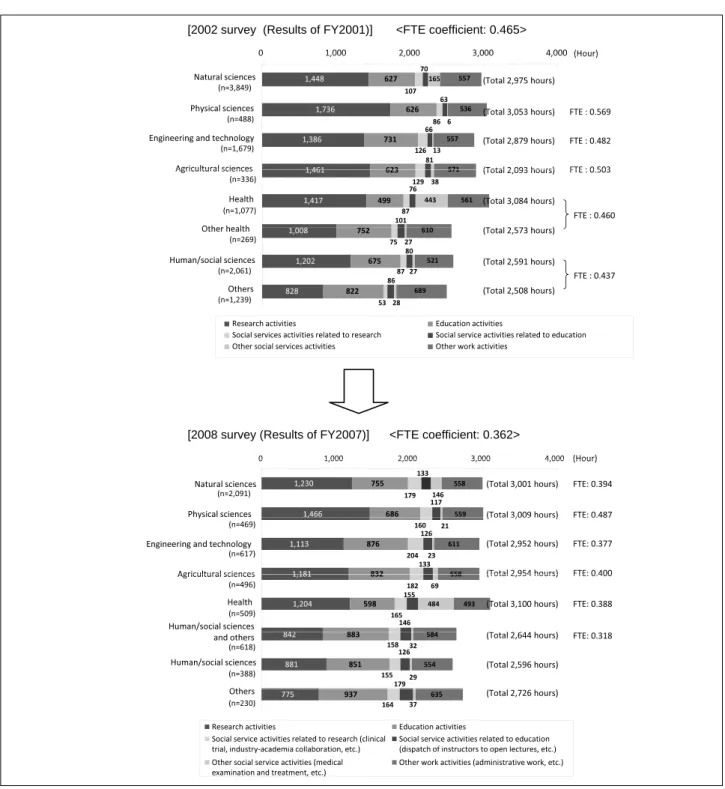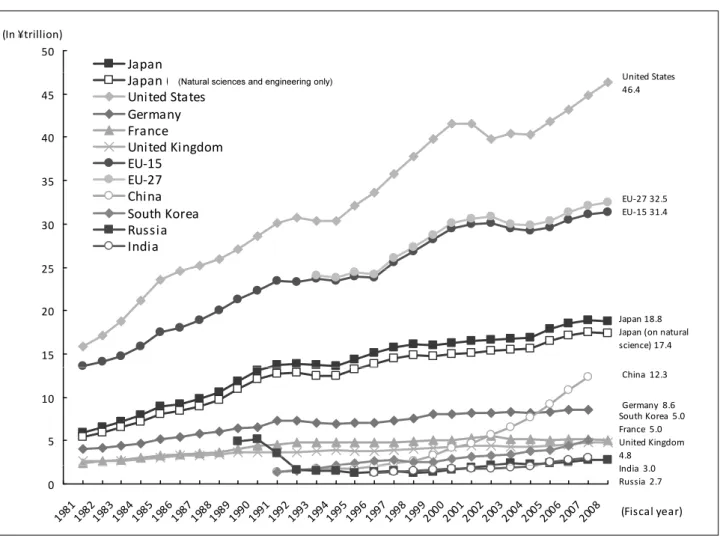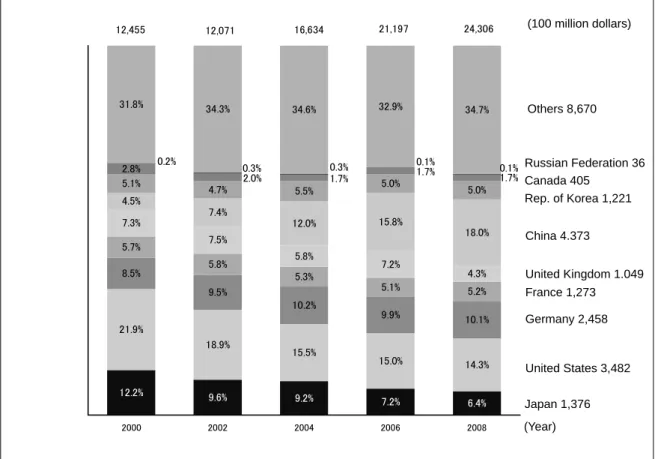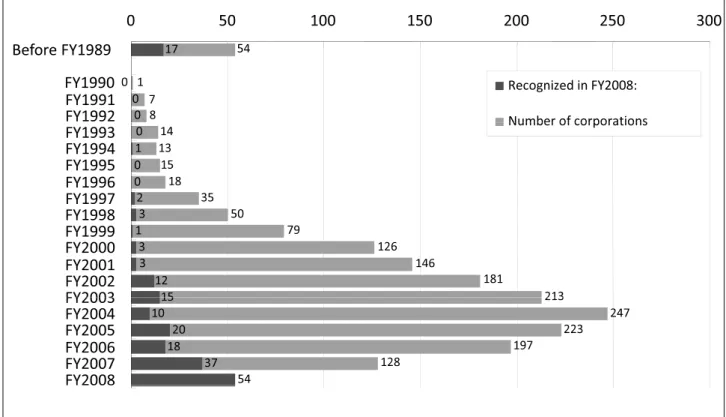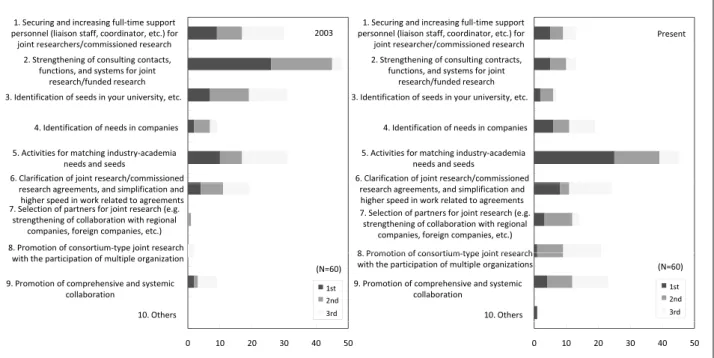Introduction
On June 15, 2010, the “White Paper on Science and Technology 2010 (annual report on the promotion of science and technology in fi scal 2009)”[1] was decided at a Cabinet meeting and was reported to the Diet.
The White Paper on Science and Technology, which is stipulated in Article 8 of the Science and Technology Basic Law (Law No. 130 of 1995), is a report on measures implemented by the government concerning the promotion of science and technology.
On the other hand, the White Paper on Education, Culture, Sports, Science and Technology, which is not a legally-required document, offers a broad introduction of measures implemented by the Ministry of Education, Culture, Sports, Science and Technology (MEXT). They are both prepared by the MEXT but their orientation is different.
As Table 1 shows, Part 1 of the science and technology white paper focuses on a different theme every year. Initially, the white paper consisted of three parts, but starting with the FY2008 edition, it has come to incorporate in Part 1 the “Current Status of Science and Technology in Japan and Other Nations,”
which had previously formed Part 2.
Part 2 of recent science and technology white papers, “Measures Implemented to Promote Science and Technology” (which formed Part 3 of previous white papers), carries reports prepared by ministries and agencies on measures adopted by them for the promotion of science and technology in the previous year.
Part 1 of the FY2010 white paper focuses on “A new frontier to be extended by value-creating human resources ~ How science and technology should be for Japan to make a new start.”
“Value-creating human resources” is a coined
6
Main Points of White Paper on Science and Technology 2010
Yuko ITO Division of Research and Coordination, Science and Technology Policy Bureau
1
phrase meaning “human recourses essential for the creation of new values.” They include “not only researchers and engineers but also persons involved in the management of universities, research institutes, private corporations and administrative organizations, intellectual property-related human resources, persons engaged in industry-academic-government collaboration, and science and mathematics teachers fostering next-generation human resources.” Japan is faced with a host of challenges, including global threats, such as global environmental issues, and socio-economic issues, such as the declining birthrate and the growing proportion of elderly people. Under such severe circumstances, in order to continue to create innovations and generate new values in Japan, it is necessary for all human resources working actively in various fields to further enhance their respective creativity and productivity. It is also important to develop a society where such value-creating human resources can perform their skills.
In light of these circumstances, Part 1 of this year’s white paper takes up the issues of strengthening science/technology and basic scientific capability conducive to the solution of problems in Chapter 1, developing human resources, improving the research environment, and creating opportunities to generate innovation in Chapter 2, and considering the relationship between society/people and science/
technology in Chapter 3. Throughout the chapters, the white paper explains that there are various problems with regard to human resources in Japan and that these problems need to be solved.
(I ncident ally, i n th is yea r’s wh ite paper,
“kagakugijutsu,” a generic term used to refer to
“kagaku (science)” and “gijutsu (technology) is written as “kagaku・gijutsu,” except for referring to law names, for the fi rst time in line with the notation adopted in other government documents, such as
the “New Growth Strategy (Basic Policy) (Cabinet decision in December 2009).”
The following are the main points, chapter by chapter, of Part 1 of this year’s white paper on science and technology.
Main Points of Part 1
2-1 Points of “Chapter 1: Science and Technology Carving out a Future and Solving Challenges”
Chapter 1 f irst describes world sit uations surrounding Japan as the background of science and technology policy.
Issue date Title of Part 1 Title of Part 2 Title of Part 3
1996 Aiming for Front Runner in Research Activities
The Current Status of Science and Technology in Japan and Other Nations
Measures Adopted for Promotion of Science and Technology
1997 A i m i n g f o r C r e a t i n g a n O p e n Research Society
The Current Status of Science and Technology in Japan and Other Nations
Measures Adopted for Promotion of Science and Technology
1998 In the Era of Reform The Current Status of Science and Technology in Japan and Other Nations
Measures Adopted for Promotion of Science and Technology
1999 New Developments in Science and Technology Policy: Responding to National and Societal Needs
The Current Status of Science and Technology in Japan and Other Nations
Measures Adopted for Promotion of Science and Technology
2000 Towards the 21st Century S t a t e o f S c i e n c e a n d Technology Activities in Japan and Overseas
P o l i c i e s A d o p t e d t o P r o m o t e Science and Technology
2001 Creativity of Japan’s Science and Technology
The Current Status of Science and Technology in Japan and Other Nations
Measures Adopted for Promotion of Science and Technology
2002 Using Knowledge to Create Society and Economy for a New Era
The Current Status of Science and Technology in Japan and Other Nations
Measures Adopted for Promotion of Science and Technology
2003 Human Resources in Science and Technology Required of Japan in the Future
The Current Status of Science and Technology in Japan and Other Nations
Measures Adopted for Promotion of Science and Technology
2004 T h e F u t u r e o f S c i e n c e a n d Technology and Society
The Current Status of Science and Technology in Japan and Other Nations
Measures Adopted for Promotion of Science and Technology 2005 Japan’s Scientifi c and Technological
Capabilities
The Current Status of Science and Technology in Japan and Other Nations
Measures Adopted for Promotion of Science and Technology 2006 Challenge for Building a Future
Society: the Role of Science and Technology in an Aging Society with Fewer Children
The Current Status of Science and Technology in Japan and Other Nations
Measures Adopted for Promotion of Science and Technology
2007 Results of Promotion of Science and Technology – Creation, Utilization and Succession of Knowledge –
The Current Status of Science and Technology in Japan and Other Nations
Measures Adopted for Promotion of Science and Technology 2008 T h e S t a t e o f S c i e n c e a n d
Technology in Transcending the S t o r m o f F i e r c e I n t e r n a t i o n a l Competition (97)
M e a s u r e s I m p l e m e n t e d t o P r o m o t e S c i e n c e a n d Technology (126)
2009 Towards Japan’s Own Innovative Science and Technology across the Threshold of Global Transition (85)
M e a s u r e s I m p l e m e n t e d t o P r o m o t e S c i e n c e a n d Technology (140)
2010 A new frontier to be extended by value-creating human resources ~ How science and technology should be for Japan to make a new start (99)
M e a s u r e s I m p l e m e n t e d t o P r o m o t e S c i e n c e a n d Technology (124)
Table 1 : Structure and Titles of Science and Technology White Papers
Source: Homepage of the MEXT[2]
*Figures in the brackets are the number of pages
2
Situations surrounding Japan, such as global environmental issues, are severe. In order to respond to the demands from society and the people, it is important to promote basic research, which is the source of knowledge, and research and development conducive to the solution of problems (technologies to cope with global warming, S&T conducive to people’s health, and S&T conducive to social safety) and create innovation. It is necessary to clarify our intention to pioneer the future of Japan and humanity.
(1) Science and technology contributing to creation of a low-carbon society
(State of research and development aimed at solving global warming issues)
There are active movements around the world to cope with global warming and realize a low-carbon society. According to the UN Environment Program (UNEP), the global market for environment-related business, which stood at about €1.0 trillion (about
¥150 trillion) in 2005, is expected to more than double to about €2.2 trillion (about ¥300 trillion) by 2020.
Efforts for developing technologies to cope with global warming have intensifi ed around the world. For instance, the number of research papers on solar cell and fuel cell power generation systems has increased both in Japan and other countries (Figure 1). The number of research papers on the dye-sensitized solar cell, which is drawing attention as a next-generation
technology, has also increased drastically, suggesting active R&D activities in this area.
The following are examples of R&D of global warming countermeasure technologies.
○Technologies to reduce greenhouse gas emissions (R&D of next-generation solar cells, Biomass energy technology, R&D of electric storage technology, R&D of fuel cell power generation system, Smart grid technology, Carbon dioxide capture and storage technology)
○ Adaptive technology for global warming and environment prediction/observation technology
○ International joint research to facilitate solving global warming issues
(Integration of knowledge to realize a low-carbon society)
In order to promote research and development of global warming countermeasure technology, it is hoped that as many excellent researchers, basic scientists in particular, as possible will take interest in global warming issues and realizing a low-carbon society and get actively involved to solve the issues. It is important to share the common goal of realizing a low-carbon society, to promote comprehensive efforts involving researchers in diverse fi elds, including those in natural science as well as those in art and social sciences, and to facilitate smooth collaboration and networking of researchers and research institutes in various fi elds.
㪊㪇㪇
^ŽůĂƌĐĞůů;ǁŽƌůĚͿ
ƌ
㪌㪇㪇
㪍㪇㪇
LJĞͲƐĞŶƐŝƚŝnjĞĚ
㪉㪇㪇
䈱 િ䈶 䋨䋦䋩
^ŽůĂƌĐĞůů;:ĂƉĂŶͿƚŚĞŶƵŵďĞƌ ƉĞƌƐ;йͿ㪊㪇㪇 㪋㪇㪇
િ 䈶䋨 䋦 䋩
KƌŐĂŶŝĐ ŶƚŚĞ ĂƉĞƌƐ;йͿ
⺰ᢥ 䈱 㪈㪇㪇
ůůƉĂƉĞƌƐ;ǁŽƌůĚͿ
'ƌŽǁƚŚŝŶ ŽĨƉĂƉ
㪈㪇㪇
⺰ᢥ 䈱 િ 㪉㪇㪇
KƌŐĂŶŝĐ^LJƐƚĞŵĂƚŝĐ ƚĞĐŚŶŽůŽŐŝĞƐ /ŶŽƌŐĂŶŝĐ 'ƌŽǁƚŚŝŶ ŶƵŵďĞƌŽĨƉĂ
㪇
㪉㪇㪇㪇 㪉㪇㪇㪉 㪉㪇㪇㪋 㪉㪇㪇㪍 㪉㪇㪇㪏
zĞĂƌᐕ
㪇 㪈㪇㪇
㪉㪇㪇㪇 㪉㪇㪇㪉 㪉㪇㪇㪋 㪉㪇㪇㪍 㪉㪇㪇㪏
ᐕ
/ŶŽƌŐĂŶŝĐ
ᐕ
zĞĂƌzĞĂƌ
Figure 1 : Increase in the number of papers in the world and in Japan in relation to solar cells and fuel cell power systems
Source: Innovation Policy Research Center, University of Tokyo The left fi gure shows the increase in the number of papers in Japan and the world.
The right fi gure shows the increase in the number in the world for different types of cells.
(2) Science and technology contributing to safe and sophisticated human life
In order for the people to enjoy healthy and high- quality life, it is necessary to promote R&D and innovation conducive to the creation of innovative medicines and healthcare technology and propel further growth of Japan by positioning industries based on science and technology related to medical-, nursing- and health-care as Japan’s leading industries.
Research and development in these fi elds plays an important role in building a foundation for safe and high-quality national life. However, since it takes much time and effort to develop a viable industry and since it is not easy to produce short-term results, it is necessary for the government to actively promote such efforts.
(Science and technology conducive to people’s health)
Challenging R&D efforts are being made in life science and many other fields ranging from basic research, such as investigation of vital functions and the cause and condition of diseases, to research and development of new medicines, medical equipment and medical-treatment and nursing-care technologies.
The following are R&D examples.
○ Research to deepen understanding of living bodies and develop future medical treatment methods
・Shedding light on the mechanism of the living body’s pathogen recognition (innate immunity)
・Research on diseases and development of medicines and medical technology by using genetically-modifi ed primates
○ Research on innovative medical technology conducive to the treatment of cardiac disease, cancer and dementia
・R&D to realize regenerative medicine using iPS cells
・Innovative tissue-engineered regeneration medicine
・New drug treatment of cancer ~ Development of peptide-vaccine treatment
・Research to shed light on the cause of impaired cognitive function
○ R&D leading to new medical equipment and service support
・R&D of r a d iot he r apy e qu ipme nt t hat automatically tracks and treats malignant
tumors
・Life-supporting service robot
○ E f f o r t s f o r h e a l t h s c i e n c e t h r o u g h interdisciplinary collaboration, including art and social sciences.
・R e s e a r c h a n d e d u c a t i o n c e n t e r s fo r interdisciplinary study on aging society
・“Silver New Deal,” a policy recommendation in business-academia collaboration
・Promotion of good health in collaboration with local communities
(Science and technology conducive to social safety and security)
In order to build a society where people can live in peace and security, it is necessary to have measures in place to prevent the occurrence of incidents that may cause immense influence on people’s life, or to minimize the infl uence of such incidents.
The following are R&D examples.
○Science and technology to prevent/reduce natural disasters
○ Science and technology ensure stable supply of foods ~ cultivation technology ~
○ Science and technology to detect dangers, such as terrorism
○ Promoting countermeasures against emerging/
reemerging infectious diseases in collaboration with other countries
○Science and technology to resolve water issues in the world
(3) Enhancement of basic science capability (Importance of basic research)
Basic research creates human wisdom and is the source of knowledge. It also creates knowledge, which is the source of innovation. The 3rd Science and Technology Basic Plan states that research based on the free ideas of researchers promotes a variety of research activities from the very early stages in the pursuit of universal knowledge from a long-term perspective. The Basic Plan also states that such research has been supported by grants-in-aid for basic research and scientifi c research.
However, Figure 2 shows that “the diversity of basic research in Japan as a whole” has decreased from what it was in 2001. It also points out that a decrease in research funds from the basic research subsidy foundational budgets may impede unique and creative
research by young researchers who have the potential to produce world-leading research results.
(Toward strengthening Japan’s basic scientific capability)
The Basic Scientific Capability Enhancement Committee of the MEXT conducted intensive discussions on strengthening Japan’s basic scientific capability and came up with a “Proposal toward Strengthening Basic Scientific Capability” in August 2009. It calls for integrated promotion of the S&T system, including investment in basic research, improvement of research infrastructure, and development of human resources with the aim of raising the education and research capability of Japanese universities and research institutions and
“leading the world with science and technology.”
(4) Current situation in Japan viewed in the papers We need to be careful when we analyze research paper-related indicators, such as the number of research papers issued and the number of times research papers are cited, as they have their good points and bad points as well as their limits. Still, they show one aspect of the level of Japanese science and technology and therefore are basic information to understand the current state of the Japanese S&T system.
The number of top 10% research papers in all disciplines in Japan (the number of papers in the top
10% group in each discipline in terms of times the papers are cited) increased from 3,470 in 1988 to 5,283 in 2008. On the other hand, while the number of top 10% papers in China has drastically increased its share in the world, the shares of Japanese and U.S. top 10% papers have decreased (Figure 3).
2-2 Main Points of “Chapter 2: S&T Systems that Mobilize People and Connect Knowledge”
Based on the progress in international science and technology and Japan’s position that were described in Chapter 1, Chapter 2 analyzes the current state of human resources in Japan, the research environment, and conditions of innovation creation, and describes the kinds of human resources and environment required.
In order to create scientific and technological innovation contributing to the enhancement of basic scientific capability and the solution of issues, it is essential to develop and secure not only researchers and engineers but also “value-creating human resources” playing important roles in science and technology activities.
ŝǀĞƌƐŝƚLJŽĨŝŶƚŚĞƌĞƐĞĂƌĐŚŽĨǁŚŽůĞ:ĂƉĂŶEсϵϮϬ
ZĞƐĞĂƌĐŚƌĞƋƵŝƌŝŶŐĂůŽŶŐƚŝŵĞEсϵϮϯ
㪄㪉㪅㪌 㪄㪈㪅㪋
ĞĐƌĞĂƐŝŶŐ /ŶĐƌĞĂƐŝŶŐ
&ƵŶĚĂŵĞŶƚĂůƌĞƐĞĂƌĐŚ͕ƐƵĐŚĂƐŽŶŵĞƚƌŽůŽŐŝĐĂůƐƚĂŶĚĂƌĚĂŶĚŵĂƚĞƌŝĂůƚĞƐƚƐEсϴϵϵ
ŚĂůůĞŶŐŝŶŐƌĞƐĞĂƌĐŚĐƌĞĂƚŝŶŐŶĞǁƌĞƐĞĂƌĐŚĂƌĞĂƐEсϵϭϵ
ZĞƐĞĂƌĐŚŽŶƌĞŐŝŽŶƐƉĞĐŝĨŝĐŝƐƐƵĞƐEсϵϭϭ
ZĞƐĞĂƌĐŚ ƚŚĂƚ ĂƚƚĞŵƉƚƐ ĨƵƐŝŽŶ ŽĨ ĚŝĨĨĞƌĞŶƚ ĨŝĞůĚƐ Eсϵϭϴ
㪇 㪎 㪄㪇㪅㪏
㪄㪈㪅㪏
㪄㪇㪅㪉
ZĞƐĞĂƌĐŚƚŚĂƚĂƚƚĞŵƉƚƐĨƵƐŝŽŶŽĨĚŝĨĨĞƌĞŶƚĨŝĞůĚƐEсϵϭϴ
ZĞƐĞĂƌĐŚǁŝƚŚŚŝŐŚƉƌŽďĂďŝůŝƚLJŽĨƉŽƐŝƚŝǀĞŽƵƚĐŽŵĞƐEсϵϮϬ
ZĞƐĞĂƌĐŚƉƌŽĚƵĐŝŶŐƐŚŽƌƚͲƚĞƌŵŽƵƚĐŽŵĞƐEсϵϮϮ
ZĞƐĞĂƌĐŚĨŽůůŽǁŝŶŐƚŚĞƚĞŵƉŽƌĂƌLJƚƌĞŶĚƐEсϵϮϮ
㪉 㪋
㪉㪅㪇 㪈㪅㪊 㪇㪅㪎
Ő Ɖ LJ
㪉㪅㪋
㪄㪌 㪄㪋 㪄㪊 㪄㪉 㪄㪈 㪇 㪈 㪉 㪊 㪋 㪌
Figure 2 : Diversity in the basic research (Comparison to around 2001)
Source: “Analytical Report for 2009 Expert Survey on Japanese S&T System and S&T Activities by Fields,”
National Institute of Science and Technology Policy (NISTEP)
(1) Developing value-creating human resources
① Promotion of human resources development and their performance
(Present state of career path of doctorate degree holders and their problems)
There has been growing need for human resources capable of creating new values required by the society.
It is hoped that doctoral degree holders can do well in such fi elds.
The number of persons holding a doctoral degree in natural science per million population in Japan is much smaller than in Germany and the United Kingdom and even smaller than in South Korea (Figure 4).
The number of enrollments in doctorate courses in natural science in Japan, which had been increasing since 1991 on increased focus on postgraduate courses, decreased to 11,348 in 2009 after hitting a peak of 13,190 in 2003. The advancement rate from master’s course to doctorate course in natural science has been on a declining trend in recent years, especially in the physical sciences and agricultural sciences fi elds (Figure 5).
A look at the trends in the number of doctoral graduates in natural science, in the number of newly recruited university faculties, and in the age structure of university faculties reveals that the number of doctoral graduates has exceeded the number of newly recruited university faculties since 1997 and
that the ratio of young university faculties aged 37 or younger has been decreasing, while the number of postdoctoral fellows has been on an increasing trend.[3] This suggests that it has become difficult to follow an academic career path “to university faculties after completing doctorate courses and postdoctorate research.”
(Diversifi cation of career path of doctorate degree holders)
Private corporations, along with universities, are major employers. About 16% of persons who have completed doctoral courses in natural science are employed by private corporations.[4] Private Japanese corporations appear to be reluctant to recruit persons who have completed a doctorate course, with the percentage of corporations recruiting doctoral graduates “every year without fail” or “almost every year” standing at about 10%.[5] And, only 4% of researchers at private corporations are doctorate degree holders.
Doctorate degree holders can effectively use their talents as intermediaries between science/technology and the society (such as human resources related to intellectual property, coordinators for industry- academia-government collaboration, and science/
technology communicators), managers of advanced science/technology (such as technology managers, program officers, and research administrators
㪇
㪈㪇
㪈㪐㪏㪉 㪏㪋 㪏㪍 㪏㪏 㪐㪇 㪐㪉 㪐㪋 㪐㪍 㪐㪏 㪉㪇㪇㪇 㪇㪉 㪇㪋 㪇㪍 㪇㪏
ᣣᧄ ☨࿖ 䊄䉟䉿
䊐䊤䊮䉴 ⧷࿖ ਛ࿖ ⧷࿖㩷㪈㪈㪅㪏
䊄䉟䉿㩷㪈㪈㪅㪇 ਛ࿖㩷㪏㪅㪇 䊐䊤䊮䉴㩷㪎㪅㪈 ᣣᧄ㩷㪍㪅㪋
㩷㩷㩷䋨ᐕ䋩
㪌㪇
㪍㪇 㧔㧑㧕
☨࿖㩷㪋㪊㪅㪉
United States 43.2
United Kingdom 11.8
Germany 11.0 China 8.0 France 7.1 Japan 6.4 Japan
France
United States United Kingdom
Germany China
Figure 3 : Trends in the share of top 10% papers in selected countries
Source: Prepared by the NISTEP (Year)
providing research support from the aspect of application and management of competitive fund), science teachers at junior/senior high school, and administrative officers, such as national public servants. Society, for its part, is required to positively develop an environment so that doctoral degree holders can exert their talents in various fi elds.
② Development of creative research environment (Current state of research time)
A look at changes in university faculties’ full-time equivalent factors (Figure 6) shows that the average hours for research activity in all fi elds decreased in 6 years from fiscal 2001 to fiscal 2007. Although total working hours both in the areas of natural science and human and social sciences did not change much from fiscal 2001 to fiscal 2007, hours spent for research
㪉㪌㪇 㪉㪉㪏㩷㩿㪈㪉㪋㪀
;WĞƌƐŽŶͿ
㩿ੱ䋩
㪈㪌㪇
㪉㪇㪇 㪈㪏㪏㩷㩿㪈㪋㪋㪀
㪈㪉㪇 㩿 㪐㪀
㪌㪇
㪈㪇㪇 㪈㪇㪐㩷㩿㪌㪍㪀 㪐㪏㩷㩿㪎㪋㪀 㪐㪍㩷㩿㪐㪈㪀 㪈㪉㪇㩷㩿㪎㪐㪀
㪇
ᣣᧄ ☨࿖ 䊄䉟䉿 䊐䊤䊮䉴 ⧷࿖ 㖧࿖
:ĂƉĂŶ hŶŝƚĞĚ^ƚĂƚĞƐ 'ĞƌŵĂŶLJ &ƌĂŶĐĞ hŶŝƚĞĚ
<ŝŶŐĚŽŵ ^ŽƵƚŚ<ŽƌĞĂ
ℂPhysicalsciences Engineering/ ℂ
Technology Agricultural sciences
P h y s i c a l s c i e n c e s / Engineering/Agricultural sciences
Health
Figure 4 : Number of doctoral degree holders in natural sciences per million population in selected countries (2005) Source: The numbers of doctoral degree holders are based on “International Comparison of Education Indexes (2008 and 2009),” MEXT. The populations are based on “Main Science and Technology Indicators Vol. 2009/2,” OECD.
㪊㪈㪅㪈 㪊㪇
㪊㪌 䋨䋦䋩
㪈㪍 㪋 㪈㪏㪅㪍
㪉㪉㪅㪌 㪉㪇
㪉㪌
㪍 㪈
㪈㪍㪅㪋 㪈㪋㪅㪌
㪏㪅㪐
㪈㪊㪅㪋
㪌 㪈㪇 㪈㪌
㪍㪅㪈 㪇
㪌
ᐔᚑ䋳 㪈㪇
ϭϵϵϭϭϵϵϴϮϬϬϬϮϬϬϭϮϬϬϮϮϬϬϯϮϬϬϰϮϬϬϱϮϬϬϲϮϬϬϳϮϬϬϴϮϬϬϵϮϬϭϬ;zĞĂƌͿ㪈㪈 㪈㪉 㪈㪊 㪈㪋 㪈㪌 㪈㪍 㪈㪎 㪈㪏 㪈㪐 㪉㪇 㪉㪈 䋨ᐕ䋩 㪊㪈㪅㪈
㪈㪏㪅㪍 㪉㪉㪅㪌
㪅 㪈㪋㪅㪌
㪏㪅㪐
㪈㪊㪅㪋 㪅 㪊㪈㪅㪈
㪈㪏㪅㪍 㪉㪉㪅㪌
㪅 㪈㪋㪅㪌
㪏㪅㪐
㪈㪊㪅㪋 㪅 㪊㪈㪅㪈
㪈㪏㪅㪍 㪉㪉㪅㪌
㪅 㪈㪋㪅㪌
㪏㪅㪐
㪈㪊㪅㪋 㪅 㪊㪈㪅㪈
㪈㪏㪅㪍 㪉㪉㪅㪌
㪅 㪈㪋㪅㪌
㪏㪅㪐
㪈㪊㪅㪋 㪅
Physical
sciences Engineering/
Technology
Agricultural
sciences Health
Figure 5 : Trends in the ratio of students in master’s course advancing to doctoral course (Natural Sciences) Source: “School Basic Survey,” MEXT
activity decreased, while hours for education activity and hours for social service activity increased. By sector, researchers in science had the longest hours for research activity and those in engineering had the longest hours for education activity.
In order to help researchers produce better study results by effectively and efficiently utilizing their limited hours for research activity, it is essential to improve the research environment, including the improvement of R&D support and operation functions.
(R&D expenditures)
An international comparison of trends in R&D expenditures in major countries shows that, while R&D expenditures in China and the United States have increased, Japan’s R&D expenditures decreased in FY2008 for the first time in 9 years as private corporations, which account for about 80% of Japan’s R&D expenditures, slashed their spending on research (Figure 7). The ratio of R&D expenditures to Japan’s gross domestic product is 3.8% and the ratio of government research fund to GDP is 0.68%.
Ϭ ϭ͕ϬϬϬ Ϯ͕ϬϬϬ ϯ͕ϬϬϬ ϰ͕ϬϬϬ ;,ŽƵƌͿ
ϭ͕ϰϰϴ ϭ͕ϳϯϲ
ϲϮϳ
ϲϮϲ ϱϯϲ
ϭϬϳ ϳϬ
ϲϯ ϭϲϱ ϱϱϳ
Ϭ ϭ͕ϬϬϬ Ϯ͕ϬϬϬ ϯ͕ϬϬϬ ϰ͕ϬϬϬ
EĂƚƵƌĂůƐĐŝĞŶĐĞƐ
WŚLJƐŝĐĂůƐĐŝĞŶĐĞƐ
;,ŽƵƌͿ
;Ŷсϯ͕ϴϰϵͿ ;dŽƚĂůϮ͕ϵϳϱŚŽƵƌƐͿ
;dŽƚĂů ϯ Ϭϱϯ ŚŽƵƌƐͿ &d͗ Ϭ ϱϲϵ
͕ ϭ͕ϯϴϲ ϭ ϰϲϭ
ϳϯϭ ϲϮϯ
ϱϱϳ ϱϳϭ ϭϮϲ
ϲϲϴϲ
ϴϭ ϲ ϭϯ LJ
ŶŐŝŶĞĞƌŝŶŐĂŶĚƚĞĐŚŶŽůŽŐLJ
ŐƌŝĐƵůƚƵƌĂů ƐĐŝĞŶĐĞƐ
;ŶсϰϴϴͿ
;Ŷсϭ͕ϲϳϵͿ
;dŽƚĂůϯ͕ϬϱϯŚŽƵƌƐͿ
;dŽƚĂůϮ͕ϴϳϵŚŽƵƌƐͿ
;dŽƚĂů Ϯ Ϭϵϯ ŚŽƵƌƐͿ
&d͗Ϭ͘ϱϲϵ
&d͗Ϭ͘ϰϴϮ
&d͗ Ϭ ϱϬϯ ϭ͕ϰϲϭ
ϭ͕ϰϭϳ
ϲϮϯ
ϰϵϵ ϰϰϯ
ϱϳϭ ϱϲϭ ϭϮϵ ϴϳ
ϳϲ ϭϬϭ
ϯϴ ŐƌŝĐƵůƚƵƌĂůƐĐŝĞŶĐĞƐ
,ĞĂůƚŚ KƚŚĞƌ ŚĞĂůƚŚ
;ŶсϯϯϲͿ
;Ŷсϭ͕ϬϳϳͿ
;dŽƚĂůϮ͕ϬϵϯŚŽƵƌƐͿ
;dŽƚĂůϯ͕ϬϴϰŚŽƵƌƐͿ
; ů Ś Ϳ
&d͗Ϭ͘ϱϬϯ
&d͗Ϭ͘ϰϲϬ ϭ͕ϬϬϴ
ϭ͕ϮϬϮ
ϳϱϮ ϲϳϱ
ϲϭϬ ϱϮϭ ϳϱ
ϴϳ ϴϬ ϴϲ
Ϯϳ Ϯϳ KƚŚĞƌŚĞĂůƚŚ
,ƵŵĂŶͬƐŽĐŝĂůƐĐŝĞŶĐĞƐ
;ŶсϮϲϵͿ
;ŶсϮ͕ϬϲϭͿ
;dŽƚĂůϮ͕ϱϳϯŚŽƵƌƐͿ
;dŽƚĂůϮ͕ϱϵϭŚŽƵƌƐͿ
&d͗Ϭ͘ϰϯϳ
ϴϮϴ ϴϮϮ ϲϴϵ
ϱϯ Ϯϴ KƚŚĞƌƐ
ZĞƐĞĂƌĐŚĂĐƚŝǀŝƚŝĞƐ ĚƵĐĂƚŝŽŶĂĐƚŝǀŝƚŝĞƐ
^ŽĐŝĂůƐĞƌǀŝĐĞƐĂĐƚŝǀŝƚŝĞƐƌĞůĂƚĞĚƚŽƌĞƐĞĂƌĐŚ ^ŽĐŝĂůƐĞƌǀŝĐĞĂĐƚŝǀŝƚŝĞƐƌĞůĂƚĞĚƚŽĞĚƵĐĂƚŝŽŶ
;Ŷсϭ͕ϮϯϵͿ ;dŽƚĂůϮ͕ϱϬϴŚŽƵƌƐͿ
KƚŚĞƌƐŽĐŝĂůƐĞƌǀŝĐĞƐĂĐƚŝǀŝƚŝĞƐ KƚŚĞƌǁŽƌŬĂĐƚŝǀŝƚŝĞƐ
Ϭ ϭ ϬϬϬ Ϯ ϬϬϬ ϯ ϬϬϬ ϰ ϬϬϬ ;,ŽƵƌͿ
ϭ͕ϮϯϬ ϭ͕ϰϲϲ
ϳϱϱ ϲϴϲ
ϱϱϴ ϱϱϵ ϭϳϵ ϭϭϳ
ϭϯϯ ϭϰϲ
Ϭ ϭ͕ϬϬϬ Ϯ͕ϬϬϬ ϯ͕ϬϬϬ ϰ͕ϬϬϬ
EĂƚƵƌĂůƐĐŝĞŶĐĞƐ WŚLJƐŝĐĂůƐĐŝĞŶĐĞƐ
;ŶсϮ͕ϬϵϭͿ ;dŽƚĂůϯ͕ϬϬϭŚŽƵƌƐͿ
;dŽƚĂů ϯ͕ϬϬϵ ŚŽƵƌƐͿ
&d͗Ϭ͘ϯϵϰ
&d͗ Ϭ͘ϰϴϳ
;,ŽƵƌͿ
͕ ϭ͕ϭϭϯ ϭ ϭϴϭ
ϴϳϲ ϴϯϮ
ϲϭϭ ϱϱϴ ϮϬϰ
ϭϲϬ
ϭϯϯ ϭϮϲ Ϯϯ
Ϯϭ LJ
ŶŐŝŶĞĞƌŝŶŐĂŶĚƚĞĐŚŶŽůŽŐLJ ŐƌŝĐƵůƚƵƌĂů ƐĐŝĞŶĐĞƐ
;ŶсϰϲϵͿ
;ŶсϲϭϳͿ
;dŽƚĂůϯ͕ϬϬϵŚŽƵƌƐͿ
;dŽƚĂůϮ͕ϵϱϮŚŽƵƌƐͿ
;dŽƚĂů Ϯ ϵϱϰ ŚŽƵƌƐͿ
&d͗Ϭ͘ϰϴϳ
&d͗Ϭ͘ϯϳϳ
&d͗ Ϭ ϰϬϬ ϭ͕ϭϴϭ
ϭ͕ϮϬϰ ϴϰϮ
ϴϯϮ ϱϵϴ ϴϴϯ
ϰϴϰ ϱϱϴ
ϰϵϯ ϭϲϱ
ϭϴϮ
ϭϰϲ ϭϱϱ ϲϵ ŐƌŝĐƵůƚƵƌĂůƐĐŝĞŶĐĞƐ
,ĞĂůƚŚ ,ƵŵĂŶͬƐŽĐŝĂůƐĐŝĞŶĐĞƐ
;ŶсϰϵϲͿ
;ŶсϱϬϵͿ
;dŽƚĂůϮ͕ϵϱϰŚŽƵƌƐͿ
;dŽƚĂůϯ͕ϭϬϬŚŽƵƌƐͿ
; ů Ś Ϳ
&d͗Ϭ͘ϰϬϬ
&d͗Ϭ͘ϯϴϴ
ϴϰϮ ϴϴϭ
ϴϴϯ ϴϱϭ
ϱϴϰ ϱϱϰ ϭϱϴ ϭϱϱϭϳϵ
ϭϮϲ Ϯϵ ĂŶĚŽƚŚĞƌƐ ϯϮ
,ƵŵĂŶͬƐŽĐŝĂůƐĐŝĞŶĐĞƐ KƚŚ
;ŶсϲϭϴͿ
;ŶсϯϴϴͿ
;dŽƚĂůϮ͕ϲϰϰŚŽƵƌƐͿ
;dŽƚĂůϮ͕ϱϵϲŚŽƵƌƐͿ
&d͗Ϭ͘ϯϭϴ
ϳϳϱ ϵϯϳ ϲϯϱ
ϭϲϰ ϯϳ KƚŚĞƌƐ
ZĞƐĞĂƌĐŚĂĐƚŝǀŝƚŝĞƐ ĚƵĐĂƚŝŽŶĂĐƚŝǀŝƚŝĞƐ
^ŽĐŝĂůƐĞƌǀŝĐĞĂĐƚŝǀŝƚŝĞƐƌĞůĂƚĞĚƚŽƌĞƐĞĂƌĐŚ;ĐůŝŶŝĐĂů
ŝ ů ŝ Ě Ě ŝ ů ů ď ŝ Ϳ ^ŽĐŝĂůƐĞƌǀŝĐĞĂĐƚŝǀŝƚŝĞƐƌĞůĂƚĞĚƚŽĞĚƵĐĂƚŝŽŶ
;Ěŝ Ś Ĩ ŝ ůͿ
;ŶсϮϯϬͿ ;dŽƚĂůϮ͕ϳϮϲŚŽƵƌƐͿ
ƚƌŝĂů͕ŝŶĚƵƐƚƌLJͲĂĐĂĚĞŵŝĂĐŽůůĂďŽƌĂƚŝŽŶ͕ĞƚĐ͘Ϳ ;ĚŝƐƉĂƚĐŚŽĨŝŶƐƚƌƵĐƚŽƌƐƚŽŽƉĞŶůĞĐƚƵƌĞƐ͕ĞƚĐ͘Ϳ KƚŚĞƌƐŽĐŝĂůƐĞƌǀŝĐĞĂĐƚŝǀŝƚŝĞƐ;ŵĞĚŝĐĂů
ĞdžĂŵŝŶĂƚŝŽŶĂŶĚƚƌĞĂƚŵĞŶƚ͕ĞƚĐ͘Ϳ KƚŚĞƌǁŽƌŬĂĐƚŝǀŝƚŝĞƐ;ĂĚŵŝŶŝƐƚƌĂƚŝǀĞǁŽƌŬ͕ĞƚĐ͘Ϳ
Figure 6 : Changes in total working hours and activities of university faculty (from FY2001 to FY2007)
Source: “Survey on Full-Time Equivalent data for research staff members in higher education organization. (September 2009),” MEXT
[2002 survey (Results of FY2001)] <FTE coeffi cient: 0.465>
[2008 survey (Results of FY2007)] <FTE coeffi cient: 0.362>
(2) Creation of opportunities to connect knowledge with innovation
① Current state of Innovation activities (Innovation activities in companies)
Although the number of patent applications by Japanese has been on the decrease since 2005, Japan still leads the world (2008) in terms of the number of patent applications by country of origin. Japan is also number one worldwide in terms of the number of patent registrations.[6]
High-tech products (aerospace, electronics, office machinery and computers, pharmaceuticals, medical/
precision/optical instruments) are high value-added products, as they utilize advanced science and technology in their mechanisms and production process and they create innovation by influencing social life. A look at the trends in major countries’
share in exports of high-tech products reveals that China has increased its share drastically and increased its presence in the world market, while Britain, the United States and Japan saw their shares decline
sharply (Figure 8).
Innovation can be divided into two categories:
“product innovation, which is launching new products or new services into the market” and “process innovation, which is introducing new processes related to production and distribution of products and services, or improving existing processes.” In a survey on the state of innovation activities within Japanese private-sector corporations (Figure 9), nearly half of the respondents said that they realized product innovation or process innovation during the three years from FY2006 to FY2008. Many of the 2,201 corporations that responded that they had realized innovation cited “deficiency in know-how related to technology” and “shortage of competent workers” as factors inhibiting innovation. In corporate innovation activities, it is important to expand human resources having advanced knowledge, information and technology.
ϱϬ
;/ŶίƚƌŝůůŝŽŶͿ
:ĂƉĂŶ
ϰϬ
ϰϱ :ĂƉĂŶ;ŽŶŶĂƚƵƌĂůƐĐŝĞŶĐĞͿ hŶŝƚĞĚ^ƚĂƚĞƐ
'ĞƌŵĂŶLJ
&ƌĂŶĐĞ
hŶŝƚĞĚ<ŝŶŐĚŽŵ hͲϭϱ
hŶŝƚĞĚ^ƚĂƚĞƐ (Natural sciences and engineering only) ϰϲ͘ϰ
Ϯϱ ϯϬ
ϯϱ hͲϮϳ
ŚŝŶĂ
^ŽƵƚŚ<ŽƌĞĂ ZƵƐƐŝĂ /ŶĚŝĂ
hͲϮϳϯϮ͘ϱ hͲϭϱϯϭ͘ϰ
ϭϱ ϮϬ Ϯϱ
:ĂƉĂŶϭϴ͘ϴ :ĂƉĂŶ;ŽŶŶĂƚƵƌĂů ƐĐŝĞŶĐĞͿϭϳ͘ϰ
ϱ
ϭϬ 'ĞƌŵĂŶLJϴ͘ϲ
^ŽƵƚŚ<ŽƌĞĂϱ͘Ϭ
&ƌĂŶĐĞϱ͘Ϭ hŶŝƚĞĚ<ŝŶŐĚŽŵ ϰ͘ϴ
/ Ěŝ ϯ Ϭ ŚŝŶĂϭϮ͘ϯ
Ϭ ϭϵϴϭ
ϭϵϴϮ ϭϵϴϯ
ϭϵϴϰ ϭϵϴϱ
ϭϵϴϲ ϭϵϴϳ
ϭϵϴϴ ϭϵϴϵ
ϭϵϵϬ ϭϵϵϭ
ϭϵϵϮ ϭϵϵϯ
ϭϵϵϰ ϭϵϵϱ
ϭϵϵϲ ϭϵϵϳ
ϭϵϵϴ ϭϵϵϵ
ϮϬϬϬ ϮϬϬϭ
ϮϬϬϮ ϮϬϬϯ
ϮϬϬϰ ϮϬϬϱ
ϮϬϬϲ ϮϬϬϳ
ϮϬϬϴ
/ŶĚŝĂϯ͘Ϭ ZƵƐƐŝĂϮ͘ϳ
;&ŝƐĐĂůLJĞĂƌͿ
Figure 7 : Trends in R&D expenditures in selected countries/regions (on Purchasing Power Parity basis) Source: Japan: “Survey Report on Science and Technology Research”, Statistics Bureau of the Ministry of Internal Affairs and Communications; EU: Eurostat database; India: (Research fund) UNESCO Institute for Statistics R&D database and “purchasing power parity) The World Bank “World Development Indicators CD-ROM-2009; Other countries; OECD “Main Science and Technology Indicators Vol. 2009/2”; OECD purchasing power parity: OECD “Main Science and Technology Indicators Vol. 2009/2”
(Industry-academia collaboration)
Corporations’ self-fi nanced R&D funds in FY2008 totaled \14.5 trillion, of which funds paid outside, such as universities and other corporations, amounted to
\2.2 trillion
The number of joint research and business-funded research projects conducted by public and private universities has been increasing since FY2001. They have also increased in terms of value.[7]
Figure 10 shows that the number of university
ventures that were engaged in business activity as of the end of FY2008 was 1,809. The number of university ventures began to decrease in around FY2005 after increasing sharply in the preceding 10 years or so.
(Issues and Efforts Concerning Innovation System) Figure 11 shows that in joint research and funded research projects with corporations, the areas of activities focused on by universities began to
㪈㪉㪅㪉㩼 㪐㪅㪍㩼 㪐㪅㪉㩼 㪎㪅㪉㩼 㪍㪅㪋㩼
㪉㪈㪅㪐㩼
㪈㪏㪅㪐㩼
㪈㪌㪅㪌㩼
㪈㪌㪅㪇㩼 㪈㪋㪅㪊㩼
㪏㪅㪌㩼
㪐㪅㪌㩼
㪈㪇㪅㪉㩼
㪐㪅㪐㩼 㪈㪇㪅㪈㩼
㪌㪅㪎㩼
㪌㪅㪏㩼
㪌㪅㪊㩼 㪌㪅㪈㩼 㪌㪅㪉㩼
㪎㪅㪊㩼
㪎㪅㪌㩼
㪌㪅㪏㩼 㪎㪅㪉㩼
㪋㪅㪊㩼 㪋㪅㪌㩼
㪎㪅㪋㩼
㪈㪉㪅㪇㩼 㪈㪌㪅㪏㩼
㪌㪅㪈㩼 㪋㪅㪎㩼 㪌㪅㪌㩼 㪌㪅㪇㩼
㪌㪅㪇㩼
㪊㪈㪅㪏㩼 㪊㪋㪅㪊㩼 㪊㪋㪅㪍㩼 㪊㪉㪅㪐㩼 㪊㪋㪅㪎㩼
㪈㪏㪅㪇㩼
㪉㪅㪏㩼 㪉㪅㪇㩼 㪈㪅㪎㩼 㪈㪅㪎㩼 㪈㪅㪎㩼
㪇㪅㪉㩼 㪇㪅㪊㩼 㪇㪅㪊㩼 㪇㪅㪈㩼 㪇㪅㪈㩼
㪉㪇㪇㪇 㪉㪇㪇㪉 㪉㪇㪇㪋 㪉㪇㪇㪍 㪉㪇㪇㪏
☨࿖㩷㪊㪃㪋㪏㪉
ᣣᧄ㩷㪈㪃㪊㪎㪍 䊄䉟䉿㩷㪉㪃㪋㪌㪏 䊐䊤䊮䉴㩷㪈㪃㪉㪎㪊
⧷࿖㩷㪈㪃㪇㪋㪐 䈠䈱ઁ㩷㪏㪃㪍㪎㪇
㪈㪉㪃㪋㪌㪌 㪈㪉㪃㪇㪎㪈 㪈㪍㪃㪍㪊㪋 㪉㪈㪃㪈㪐㪎 㪉㪋㪃㪊㪇㪍
䋨ᐕ䋩 䋨ం䊄䊦䋩
㖧࿖㩷㪈㪃㪉㪉㪈 䉦䊅䉻䇭㪋㪇㪌
ਛ࿖㩷㪋㪃㪊㪎㪊 䊨䉲䉝㩷㩷㪊㪍
(100 million dollars)
Others 8,670
Russian Federation 36 Canada 405
Rep. of Korea 1,221
China 4.373
United Kingdom 1.049 France 1,273 Germany 2,458
United States 3,482
Japan 1,376 (Year)
Figure 8 : Export market share for high-tech products in selected countries
Source: OECD “Main Science and Technology Indicators Vol. 2009/2”
Figure 9 : Percentage of companies that realized innovations
Source: “Report on Japanese National Innovation Survey 2009,” NISTEP WƌŽĚƵĐƚŝŶŶŽǀĂƚŝŽŶ ;ϯϭ͘ϰйͿ
ϭϬ͘ϯ Ϯϭ͘ϭ ϭϲ͘ϲ
;Ŷсϰ͕ϱϳϵĐŽƌƉŽƌĂƚŝŽŶƐͿůů ϰϴ͘ϭй
WƌŽĐĞƐƐŝŶŶŽǀĂƚŝŽŶ ;ϯϳ͘ϳйͿ
ϴ͘Ϯ ϭϬ͘ϳ ϭϰ͘Ϯ
^ŵĂůůͲƐŝnjĞĚĐŽƌƉŽƌĂƚŝŽŶƐ
; ϭ ϭϳϵ ƚŝ Ϳ ϯϯ͘ϭй
ϵ͘ϰ ϭϲ͘Ϯ ϭϴ͘ϰ
DĞĚŝƵŵͲƐŝnjĞĚĐŽƌƉŽƌĂƚŝŽŶƐ
;Ŷсϭ͕ϭϴϮĐŽƌƉŽƌĂƚŝŽŶƐͿ
;Ŷсϭ͕ϭϳϵĐŽƌƉŽƌĂƚŝŽŶƐͿ
ϰϰ͘Ϭй
ϭϭ͘ϵ Ϯϵ͘ϯ ϭϳ͘Ϭ
>ĂƌŐĞͲƐŝnjĞĚĐŽƌƉŽƌĂƚŝŽŶƐ
;ŶсϮ͕ϮϭϴĐŽƌƉŽƌĂƚŝŽŶƐͿ ϱϴ͘Ϯй
Ϭ ϭϬ ϮϬ ϯϬ ϰϬ ϱϬ ϲϬ ϳϬ;йͿ
change in FY2003 through FY2008. The areas of activities focused on by universities in FY2008 were
“matching industry-academia needs and seeds” and
“identifi cation of needs in companies.”
Recently, there are growing moves to promote R&D by forming a network of experts of organizations in various fields, by creating an innovation platform (intellectual platform) that produces new methodology or breakthrough and by studying strategies through collaboration of industry, government and academia (R&D-type independent administrative institutions, etc.). (Example; “Tsukuba Innovation Arena,” a global research center for nanotechnology innovation).
Also, the formation of information networks, like J-GLOBAL, is expected to promote new collaboration among industry, government and academia and among corporations in different fields, as such networks make information easily available to anyone.
J-GLOBAL (in operation since FY2009; Japan Science and Technology Agency) is a new service that supports knowledge and unexpected discoveries in different fi elds by mutually linking basic information concerning research and development (researchers, universities and public research institutions, research papers, patents, research projects, and scientific and technical terms, etc.).
② New systems concerning R&D institution R&D instit utions are major research and development implementation institutions along with private-sector corporations and universities. There are 38 R&D institutions (as of April 2010) defi ned under the “Research and Development Enhancement Act”
that went into effect in 2008.
Relevant ministries are now studying appropriate measures for the system of R&D institutions from the perspective of the particularity of research and development, securing excellent human resources and ensuring international competitiveness. They are expected to adopt necessary measures by October 2011. An interim report[8] proposed the establishment of a “Organization of National Institute of Research and Development (tentative),” management reform through promotion of flexible use of budget in accordance with R&D characteristics and inter-ministry efforts, and governance reform through implementation of evaluations from a global standpoint.
2-3 Main Points of “Chapter 3: Science and Technology with Society and People”
Chapter 3 discusses the importance of people’s understanding of and participation in science and technology in order to further develop the science and technology described in Chapter 1 and Chapter 2.
Ϭ ϱϬ ϭϬϬ ϭϱϬ ϮϬϬ ϮϱϬ ϯϬϬ
ϭϳ ϬϬ
Ϭ ϭ
ϴϳ
ĞĨŽƌĞ&zϭϵϴϵ ϱϰ
&zϭϵϵϬ
&zϭϵϵϭ
&zϭϵϵϮ
ZĞĐŽŐŶŝnjĞĚŝŶ&zϮϬϬϴ͗
EƵŵďĞƌ ŽĨ ĐŽƌƉŽƌĂƚŝŽŶƐ Ϭ
ϭ ϬϬ
Ϯϯ ϭϯϭϰϭϱϭϴ ϯϱ ϱϬ
&zϭϵϵϯ
&zϭϵϵϰ
&zϭϵϵϱ
&zϭϵϵϲ
&zϭϵϵϳ
&zϭϵϵϴ
EƵŵďĞƌŽĨĐŽƌƉŽƌĂƚŝŽŶƐ
ϭϮϭϱ ϯ ϭϯϯ
Ϯϭϯ ϭϰϲ ϭϴϭ
ϭϮϲ ϱϬ ϳϵ
&zϭϵϵϴ
&zϭϵϵϵ
&zϮϬϬϬ
&zϮϬϬϭ
&zϮϬϬϮ
&zϮϬϬϯ
ϭϴϮϬ ϯϳ ϭϬϭϱ
ϱϰ ϭϮϴ ϭϵϳ ϮϭϯϮϮϯ Ϯϰϳ
&zϮϬϬϯ
&zϮϬϬϰ
&zϮϬϬϱ
&zϮϬϬϲ
&zϮϬϬϳ
&zϮϬϬϴϬϬϴ
Figure 10 : Trends in the number of university ventures founded each year
Source: FY2008 survey commissioned by the Ministry of Economy, Trade and Industry, “Basic Survey on University Ventures,” Japan Economic Research Institute
Amid deepening relationship between science/
technology and society and growing calls for reflecting public opinions on policies and research, activities to promote dialogue between researchers and the people have increased. After the change of government, new efforts are being made to make the budget-making process focused and efficient and to secure transparency of the policy-making process.
(1) Enhancing of understanding and sympathy for science and technology
The 3rd Science and Technology Basic Plan calls for promoting outreach activity (interactive communication activity between researchers and people to have the researchers share people’s needs through dialogue). In recent years, many outreach activities have come to be performed. In order to promote outreach activity, it is hoped that universities will make systematic efforts to develop and secure expert human resources.
Science and natural history museums have played a central role in S&T communication activities by offering easy-to-understand answer books on science and technology, displaying samples, holding lecture meetings and events, and offering hands-on learning experience. It is hoped that they will continue to develop human resources engaged in such activities and support volunteer activities.
(2) New developments in S&T policy
(Growing argument concerning science and technology)
In November 2009, the Government Revitalization Unit examined government operations, including those in the area of science and technology, and after screening processes, handed down verdicts, including reviewing some of the government operations and budget cutbacks. The verdicts caused repercussions in various circles, including academic societies. In order to reflect the voice of the people in budget making, the MEXT solicited public opinions on the projects subjected to the screening process (Nov. 16~Dec. 15, 2009) and received about 20,000 opinions.
As described above, after the change of government, the new government has been promoting S&T policy more effectively and efficiently, while reviewing the way to promote science and technology and promoting transparency through new efforts, such as seeking public comments in determining the priority of government projects.
(New developments in S&T policy)
The Council for Science and Technology Special Committee on the Science and Technology Basic Plan inof MEXT has positioned Japan’s future S&T policy as one of the main “social and public policies” to link S&T knowledge to the creation of new value for the realization of affl uent national life and human society
ϮϬϬϯ WƌĞƐĞŶƚ
ϭ͘^ĞĐƵƌŝŶŐĂŶĚŝŶĐƌĞĂƐŝŶŐĨƵůůͲƚŝŵĞƐƵƉƉŽƌƚ ƉĞƌƐŽŶŶĞů;ůŝĂŝƐŽŶƐƚĂĨĨ͕ĐŽŽƌĚŝŶĂƚŽƌ͕ĞƚĐ͘ͿĨŽƌ ũŽŝŶƚ ƌĞƐĞĂƌĐŚĞƌƐͬĐŽŵŵŝƐƐŝŽŶĞĚ ƌĞƐĞĂƌĐŚ
ϭ͘^ĞĐƵƌŝŶŐĂŶĚŝŶĐƌĞĂƐŝŶŐĨƵůůͲƚŝŵĞƐƵƉƉŽƌƚ ƉĞƌƐŽŶŶĞů;ůŝĂŝƐŽŶƐƚĂĨĨ͕ĐŽŽƌĚŝŶĂƚŽƌ͕ĞƚĐ͘ͿĨŽƌ ũŽŝŶƚ ƌĞƐĞĂƌĐŚĞƌͬĐŽŵŵŝƐƐŝŽŶĞĚ ƌĞƐĞĂƌĐŚ Ϯ͘^ƚƌĞŶŐƚŚĞŶŝŶŐŽĨĐŽŶƐƵůƚŝŶŐĐŽŶƚĂĐƚƐ͕
ĨƵŶĐƚŝŽŶƐ͕ ĂŶĚƐLJƐƚĞŵƐĨŽƌũŽŝŶƚ ƌĞƐĞĂƌĐŚͬĨƵŶĚĞĚƌĞƐĞĂƌĐŚ ϯ͘/ĚĞŶƚŝĨŝĐĂƚŝŽŶŽĨ ƐĞĞĚƐŝŶLJŽƵƌƵŶŝǀĞƌƐŝƚLJ͕ĞƚĐ͘
ũŽŝŶƚƌĞƐĞĂƌĐŚĞƌƐͬĐŽŵŵŝƐƐŝŽŶĞĚƌĞƐĞĂƌĐŚ
Ϯ͘^ƚƌĞŶŐƚŚĞŶŝŶŐŽĨĐŽŶƐƵůƚŝŶŐĐŽŶƚƌĂĐƚƐ͕
ĨƵŶĐƚŝŽŶƐ͕ ĂŶĚƐLJƐƚĞŵƐĨŽƌũŽŝŶƚ ƌĞƐĞĂƌĐŚͬĨƵŶĚĞĚƌĞƐĞĂƌĐŚ ϯ͘/ĚĞŶƚŝĨŝĐĂƚŝŽŶŽĨ ƐĞĞĚƐŝŶLJŽƵƌƵŶŝǀĞƌƐŝƚLJ͕ĞƚĐ͘
ũŽŝŶƚƌĞƐĞĂƌĐŚĞƌͬĐŽŵŵŝƐƐŝŽŶĞĚƌĞƐĞĂƌĐŚ
ϰ͘/ĚĞŶƚŝĨŝĐĂƚŝŽŶŽĨŶĞĞĚƐŝŶĐŽŵƉĂŶŝĞƐ ϱ͘ĐƚŝǀŝƚŝĞƐ ĨŽƌŵĂƚĐŚŝŶŐ ŝŶĚƵƐƚƌLJͲĂĐĂĚĞŵŝĂ
ŶĞĞĚƐĂŶĚƐĞĞĚƐ
ϲ͘ůĂƌŝĨŝĐĂƚŝŽŶŽĨũŽŝŶƚ ƌĞƐĞĂƌĐŚͬĐŽŵŵŝƐƐŝŽŶĞĚ
ϰ͘/ĚĞŶƚŝĨŝĐĂƚŝŽŶŽĨ ŶĞĞĚƐ ŝŶĐŽŵƉĂŶŝĞƐ ϱ͘ĐƚŝǀŝƚŝĞƐĨŽƌŵĂƚĐŚŝŶŐ ŝŶĚƵƐƚƌLJͲĂĐĂĚĞŵŝĂ
ŶĞĞĚƐĂŶĚƐĞĞĚƐ
ϲ͘ůĂƌŝĨŝĐĂƚŝŽŶŽĨũŽŝŶƚ ƌĞƐĞĂƌĐŚͬĐŽŵŵŝƐƐŝŽŶĞĚ ƌĞƐĞĂƌĐŚĂŐƌĞĞŵĞŶƚƐ͕ĂŶĚƐŝŵƉůŝĨŝĐĂƚŝŽŶĂŶĚ
ŚŝŐŚĞƌƐƉĞĞĚŝŶǁŽƌŬƌĞůĂƚĞĚƚŽĂŐƌĞĞŵĞŶƚƐ ϳ͘^ĞůĞĐƚŝŽŶŽĨƉĂƌƚŶĞƌƐĨŽƌũŽŝŶƚƌĞƐĞĂƌĐŚ;Ğ͘Ő͘
ƐƚƌĞŶŐƚŚĞŶŝŶŐŽĨĐŽůůĂďŽƌĂƚŝŽŶǁŝƚŚƌĞŐŝŽŶĂů ĐŽŵƉĂŶŝĞƐ͕ĨŽƌĞŝŐŶ ĐŽŵƉĂŶŝĞƐ͕ĞƚĐ͘Ϳ ϴ͘WƌŽŵŽƚŝŽŶŽĨĐŽŶƐŽƌƚŝƵŵͲƚLJƉĞ ũŽŝŶƚƌĞƐĞĂƌĐŚ
ƌĞƐĞĂƌĐŚĂŐƌĞĞŵĞŶƚƐ͕ĂŶĚƐŝŵƉůŝĨŝĐĂƚŝŽŶĂŶĚ ŚŝŐŚĞƌƐƉĞĞĚŝŶǁŽƌŬ ƌĞůĂƚĞĚƚŽĂŐƌĞĞŵĞŶƚƐ ϳ͘^ĞůĞĐƚŝŽŶŽĨƉĂƌƚŶĞƌƐĨŽƌũŽŝŶƚƌĞƐĞĂƌĐŚ ;Ğ͘Ő͘
ƐƚƌĞŶŐƚŚĞŶŝŶŐŽĨĐŽůůĂďŽƌĂƚŝŽŶǁŝƚŚƌĞŐŝŽŶĂů ĐŽŵƉĂŶŝĞƐ͕ĨŽƌĞŝŐŶ ĐŽŵƉĂŶŝĞƐ͕ĞƚĐ͘Ϳ ϴ WƌŽŵŽƚŝŽŶ ŽĨ ĐŽŶƐŽƌƚŝƵŵ ƚLJƉĞ ũŽŝŶƚ ƌĞƐĞĂƌĐŚ ǁŝƚŚƚŚĞƉĂƌƚŝĐŝƉĂƚŝŽŶŽĨŵƵůƚŝƉůĞŽƌŐĂŶŝnjĂƚŝŽŶ
ϵ͘WƌŽŵŽƚŝŽŶŽĨĐŽŵƉƌĞŚĞŶƐŝǀĞ ĂŶĚ ƐLJƐƚĞŵŝĐ ĐŽůůĂďŽƌĂƚŝŽŶ
ϭϬ͘KƚŚĞƌƐ
;EсϲϬͿ ϭƐƚ ϮŶĚ ϯƌĚ
;EсϲϬͿ ϭƐƚ ϮŶĚ ϯƌĚ ϴ͘WƌŽŵŽƚŝŽŶŽĨĐŽŶƐŽƌƚŝƵŵͲƚLJƉĞ ũŽŝŶƚ ƌĞƐĞĂƌĐŚ
ǁŝƚŚƚŚĞƉĂƌƚŝĐŝƉĂƚŝŽŶŽĨŵƵůƚŝƉůĞŽƌŐĂŶŝnjĂƚŝŽŶƐ ϵ͘WƌŽŵŽƚŝŽŶŽĨĐŽŵƉƌĞŚĞŶƐŝǀĞ ĂŶĚ ƐLJƐƚĞŵŝĐ
ĐŽůůĂďŽƌĂƚŝŽŶ
ϭϬ͘KƚŚĞƌƐ
Ϭ ϭϬ ϮϬ ϯϬ ϰϬ ϱϬ Ϭ ϭϬ ϮϬ ϯϬ ϰϬ ϱϬ
Figure 11 : Changes in the activities focused on by universities in joint and subcontracted research
Source: “Analysis of the Innovation Systems: Part1, Creation and industry-academia-government collaboration and intellectual properties” (2009), NISTEP
